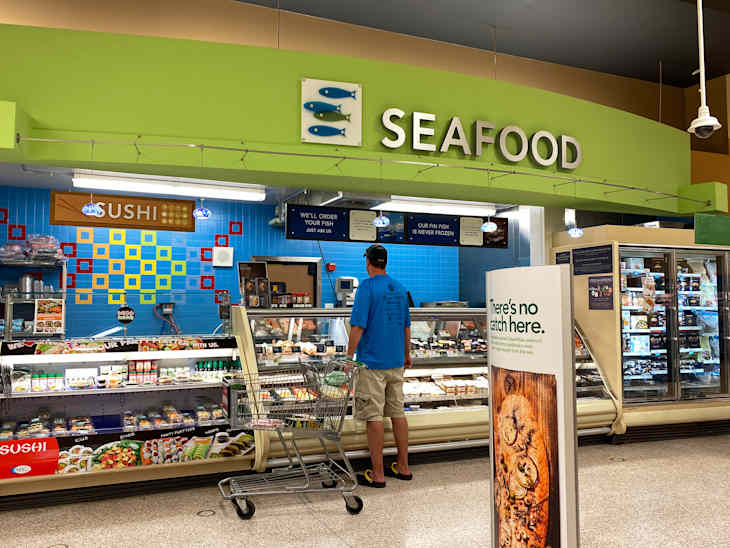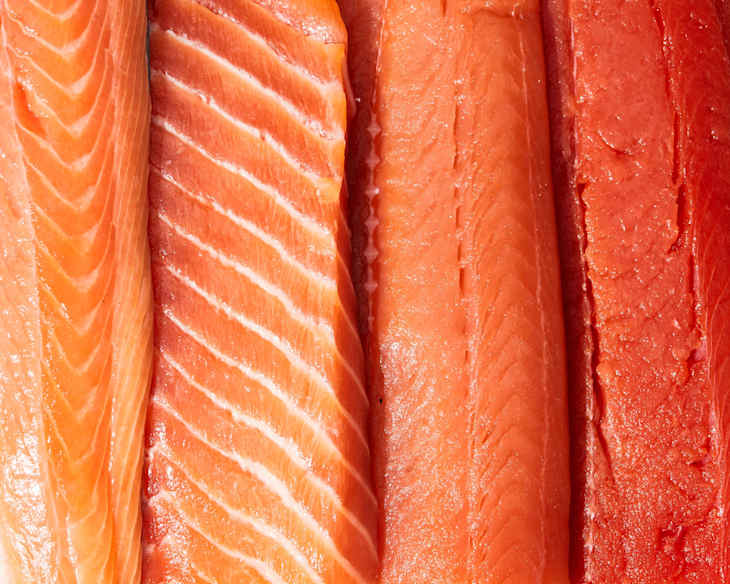

You’re probably familiar with the quote, “Give someone a fish, they’ll eat for a day. Teach someone to fish, and they’ll never go hungry.” But what if you teach someone to pick out a really good piece of fish? They’ll never have a lackluster dinner, like, ever. Right?
In a sea of grocery seafood counters (and frozen aisles), there are so many options to choose from when it comes to picking out a fish like salmon — and just as many ways to choose a less-than-flavorful cut. Do you go farmed or wild? Fresh or frozen? Should the salmon’s color remind you of a Creamsicle or fleshy grapefruit?
Rather than guess — or, worse, ask ChatGPT — I chatted with Liwei Liao, a fishmonger who’s been correcting misconceptions about seafood for more than 30 years. As the owner of The Joint fish market as well as the Uoichiba hand roll bars in Los Angeles, Liao knows a lot about salmon. Here’s what he said every salmon-enthusiast should keep in mind before their next shop.

1. Ignore the day of the week.
Long gone are the days of avoiding buying fish on Mondays! “Day of the week is a myth for grocery salmon,” Liao says. This is largely due to frequent deliveries in our very global supply chain, where fish is delivered to stores nearly every day.
Liao adds that this does not necessarily mean fish is necessarily fresher than ever. Fish is often in the cold chain for more than two weeks before it gets to the grocery store. Keeping your eye out for other markers (more on this in just a second) is more important than a date label.
2. Avoid “wet” salmon.
Leave the salmon-colored paint swatches at home, and instead check to see if your salmon is, well, still swimming. “Look for fillets that are tight and dry, not sitting in water or seem soggy,” says Liao.
As he explains, a fillet’s color depends on the species of salmon, which can vary quite a lot, while excess moisture is typically to blame for pale or discolored cuts. A drier cut will also be more tender and buttery once cooked.
3. Take “sustainable” claims with a grain of (sea) salt.
Just as people debate the “right” salmon-y shade of salmon, labeling a fish “sustainable” can also cause confusion. “Everyone’s definition of sustainable is different,” says Liao. “The problem nowadays is that it’s a term used as a marketing tool to sell more fish, but most [companies] cannot define or explain what makes their product sustainable.”
If a seafood provider is truly “sustainable,” he adds, this would mean that there’s an ecological balance and the supply will not run out from the demand. For the most up-to-date information on sustainable salmon-buying, check out Seafood Watch’s handy guide.
4. Wild isn’t necessarily better than farmed.
You also can do yourself (and your fishmonger friends) a favor by nixing this one all-too-common question at the counter: “Is it wild?” As Liao explains, “There are many farmed salmon that are of excellent quality and more responsibly raised than wild fish sourced from wild stocks.”
He urges consumers to remember that farmed salmon is often the more sustainable option. “If every human ate only wild salmon, the demand would deplete the world’s wild salmon supply extremely fast.”
5. Otherwise, frozen salmon is also a good bet.
But what if you don’t live near a fish market? Or you need some salmon ASAP and are reading this article in the middle of the grocery store? Been there!
Frozen salmon is generally a safe bet, explains Liao, because it’s frozen sooner in the cold chain than the fish that’s found in the “fresh” counter. He recommends keeping an eye out for notable producers like Ōra King Regal for King salmon, Kvarøy Arctic for Norwegian Atlantic salmon, and Loch Duart or Bakkafrost for Scottish salmon. Plus, contrary to popular belief, salmon, like many other seafoods, can be cooked frozen — no need to thaw if you’re in a rush.
6. When in doubt, go dry-aged.
Liao has long purported that fresh fish can be “boring,” while dry-aging yields salmon with a more concentrated and rich sweetness. So if you’re not sure if your fillet is too water-logged or you simply want to up your fish-cooking game, consider picking up dry-aged salmon fillets at your local fish shop. You can even experiment with dry-aging in your fridge using a fishmonger-approved cut.
Much like dry-aged steaks (which are kept in temperature-controlled refrigerators, causing the proteins to break down and lead to a tender, more rich cut), dry-aged salmon (which takes much less time; typically three to seven days) is proof that opting for “freshness” over everything is not the best route. From there, Liao likes to grill his dry-aged salmon over charcoal until the skin gets crackly (à la Bazaar Mar) — and I think my dinner plans are just about set for tonight.
7. Get familiar with your local fish shop.
It happens to us all. In our Jetson-esque current reality, where one-stop shops (and getting our groceries delivered to our door) are the name of the game, you’re left with a bland, less-than-fresh salmon fillet that you wish you could un-taste. This is where an extra stop more than pays off in dividends.
If possible, seek out the seafood markets near you — especially as salmon quality tends to degrade once it’s cut. “Buy it from a fishmonger or a fish butcher shop that cuts their own fish in-house,” says Liao. “It will be fresher!”
Got a tip for picking out seafood at the grocery store? Tell us about it in the comments below.
The Weekly Checkout
Sign up for The Weekly Checkout to get the most up-to-date grocery news, tips, and highlights.